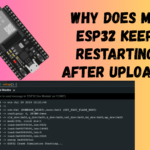Index

Introduction
Have you ever plugged in your ESP32 and felt that it’s getting too hot to touch? You’re not alone! A slightly warm ESP32 during use is expected — but if it heats up within seconds or stays hot even when idle, something might be wrong. Let’s break down the reasons, the red flags, and simple solutions to stop your ESP32 from overheating.
Normal vs. Abnormal Heating
Before jumping into fixes, it’s important to know what’s normal:
- Slight warmth is okay, especially if your ESP32 is running Wi-Fi, Bluetooth, or a high-speed loop.
- If your ESP32 gets painfully hot within 10–15 seconds of powering on — that’s not normal and needs investigation.
Common Causes of Overheating in ESP32
1. Excessive Current Draw
Connecting multiple sensors, motors, LEDs, or displays directly to the ESP32 without an external power supply can overload it. The onboard voltage regulator gets stressed and heats up fast.
Fix: Use an external power supply or separate regulator for high-power components.
2. Incorrect Power Supply
Powering the ESP32 from a 12V adapter (or unregulated supply) can cause the onboard regulator to dissipate a lot of heat. Also, cheap USB cables or damaged ports may provide unstable power.
Fix: Always use a regulated 5V supply through USB or a clean 3.3V source directly to the 3V3 pin.
3. Poor Hardware Design
Clone ESP32 boards (especially without proper thermal design or with cheap components) tend to overheat more. Breadboards also lack airflow and can trap heat.
Fix: Use a quality ESP32 dev board, and allow for airflow — avoid placing it on non-conductive surfaces like cloth.
4. Heavy Wi-Fi or Bluetooth Usage
Constant network communication, especially over weak or noisy signals, can increase CPU load and heat generation.
Fix: Optimize your code to reduce unnecessary network activity. Disable unused features like BLE if not needed.
5. Short Circuits or Wrong GPIO Use
Connecting GPIOs directly to GND or using them to drive motors without proper protection can lead to overheating — or worse, permanent damage.
Fix: Always check ESP32 pinout diagrams. Add resistors, and avoid directly connecting high loads.
Simple Fixes & Prevention Tips
Here’s what you can do right now to cool down your ESP32:
- Power it properly: USB (5V) or stable 3.3V
- Use external power for high-current modules
- Add a small heatsink or cooling fan (if needed)
- Don’t overclock unless required
- Use
esp_get_free_heap_size()in code to detect memory leaks - Use a multimeter to measure current draw (should not exceed 500mA normally)
Bonus Tip: Use the Internal Temperature Sensor
Some ESP32 versions let you read internal temperature using code. You can add this to your loop for monitoring:
// Example: Read ESP32 internal temperature
temprature_sens_read(); // returns temp in Fahrenheit - 32
Note: This value is not very accurate, but good for relative monitoring.
Conclusion
A warm ESP32 = normal.
A burning hot ESP32 = 🚨 something’s wrong.
By checking your power supply, minimizing Wi-Fi/Bluetooth load, and avoiding GPIO misuse, you can ensure your ESP32 stays cool and healthy for years to come.
If this post helped you fix your overheating issue, let me know in the comments or share your setup! And don’t forget to check out the next part of the ESP32 Troubleshooting Series

